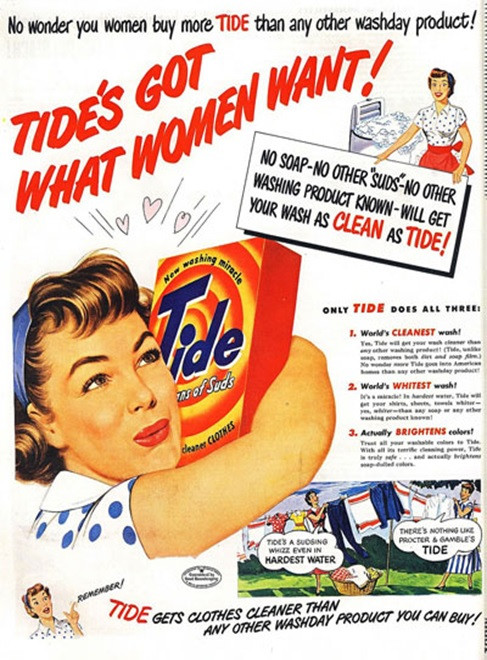Print Advert – Tide Case Study
Understanding Media and Audiences: Print Advert – Tide Case Study
Tide was a soap power produced by Proctor and Gamble in the United States in the 1950’s.
The powder still exists today (now branded as Daz Go Pods) and is still sold in the US, UK and other markets.
The advert for Tide below was created in the 1950’s by the advertising agency Benton and Bowles, which after several mergers in the late 20th century became D’arcy Masius Benton and Bowles (DMB&B) and was acquired by Publicis in 2002.

The 1950’s
The tide advert was produced in a period of great technological and economic change, a post-World War 2 boom was happening particularly in the US and new appliances such as fridges, freezers, washing machines and vacuum cleaners were being sold to consumers. These new ‘white goods’ were highly desirable for consumers.
The Housewife was the main consumer of soap powders and huge budgets were spent by companies such as Proctor and Gamble on Television and Print advertising. The term we still use today ‘Soap Opera’ was created because soap powders were advertised heavily during day time melodramas on US TV.
When tackling this case study you will need to think about the following:
How does the Tide advert above target its audience?
Talk about the messages used to attract the audience and encourage them to buy or to use more and therefore buy more.
Think about the look of the advert – Strong primary colours, large font size so it stands out in a magazine or newspaper.
The use of Hyperbole and exclamation marks makes the product seem a ‘must have’.
Appeals to the housewife ‘aspirer’ in the 1950’s a clean and perfect home was considered the ideal.
The woman in the main image is attractive and happy, the connotation would be if you use Tide you too will be happy.
Washing Machines were new technology which gave women ‘freedom’ and more leisure time so were incredibly desirable.
Modes of Address used in the advert
Think about who would have written the advert. In the 1950’s it would have almost certainly have been men! Think about how this will impact the language used. It can be argued that the advert reinforces a stereotypical patriarchal view of 1950’s society.
You need to also think about the modes of address used in the advert and why they are used.
The advert uses a conversational mode of address, in this case this is an example of synthetic personalisation (trying to create the feeling of a personal relationship between the reader and the text).
The language is colloquial, using an American informal tone, to mimic the style women of the era would have talked to each other.
Like in advertising today, facts are used to create credibility.
Using theory to analyse the Tide advert
Cultivation Theory (Gerbner and Gross), this theory surrounds the idea that the more an individual watches television the more they believe what they see on television is a depiction of reality. The theory could also apply to other media such as the Tide print advert as it involves the repeated seeing of images. You could therefore argue that the advert reinforces the stereotype of how a housewife should behave and therefore the behaviour became the norm.
